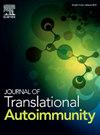The follow-up of patients with celiac disease
IF 3.6
Q2 IMMUNOLOGY
引用次数: 0
Abstract
Celiac disease (CD) is a very common immune-mediated enteropathy resulting from the interaction between dietary gluten and the immune system in genetically predisposed individuals. The immune response leads to intestinal damage, malabsorption and, ultimately, to a broad spectrum of both intestinal and extra-intestinal symptoms. According to current criteria, a proper diagnosis of CD requires an initial phase consisting of clinical case identification and serological screening that, over time, has increased in importance. In most adults and in selected children, the diagnosis is subsequently defined by histological evidence of intestinal damage as a confirmatory test, which usually returns to normal after a suitable period of a gluten-free diet (GFD). The clinical remission and disappearance of circulating antibodies after a GFD further confirm the diagnosis and represent a goal to be achieved to improve the quality of life and reduce the risk of long-term complications. However, although the diagnostic criteria for CD are well defined and described in specific guidelines, the monitoring of CD patients undergoing GFD has been less studied and, consequently, specific guidelines for this phase are still lacking. The aim of this report was to evaluate the classical tools used to monitor the adherence and response to GFD, other non-invasive biomarkers that have been proposed for CD monitoring, and the histological follow-up of CD patients in order to provide a starting point for future discussions on this specific topic.
乳糜泻患者的随访
乳糜泻(CD)是一种非常常见的免疫介导的肠病,是由遗传易感个体的饮食面筋和免疫系统相互作用引起的。免疫反应导致肠道损伤、吸收不良,并最终导致广泛的肠道和肠道外症状。根据目前的标准,乳糜泻的正确诊断需要初始阶段包括临床病例识别和血清学筛查,随着时间的推移,这一点变得越来越重要。在大多数成人和某些儿童中,诊断随后由肠道损伤的组织学证据确定为确认试验,通常在适当时期的无麸质饮食(GFD)后恢复正常。GFD后的临床缓解和循环抗体的消失进一步证实了诊断,并代表了改善生活质量和降低长期并发症风险的目标。然而,尽管CD的诊断标准在具体的指南中有很好的定义和描述,但对行GFD的CD患者的监测研究较少,因此,这一阶段的具体指南仍然缺乏。本报告的目的是评估用于监测GFD依从性和反应的经典工具,其他已提出的用于CD监测的非侵入性生物标志物,以及CD患者的组织学随访,以便为今后关于这一特定主题的讨论提供起点。
本文章由计算机程序翻译,如有差异,请以英文原文为准。
求助全文
约1分钟内获得全文
求助全文
来源期刊

Journal of Translational Autoimmunity
Medicine-Immunology and Allergy
CiteScore
7.80
自引率
2.60%
发文量
33
审稿时长
55 days
 求助内容:
求助内容: 应助结果提醒方式:
应助结果提醒方式:


